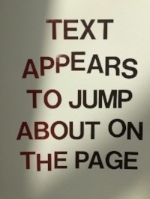Arts organizations are increasingly focusing on providing programs that are inclusive and accessible for all visitors and participants. Several past articles on AMT Lab have discussed the application of various technologies that cater to arts participants with auditory, visual and physical disabilities: Accessibility Rebooted: Technological Advancements to Improve Accessibility in Museums, Podcast: Technology’s Role in Inclusivity and Accessibility in The Arts, and Increasing Accessibility Through Virtual Reality: A Look At VR’s Therapeutic Potential. Yet AMT Lab has not addressed the emerging research on learning disabilities (LD) and how arts organizations can better accommodate the needs of visitors with LD. Arts organizations should do more research on learning disabilities to understand what accessibility technologies and services are available. Statistics from Learning Disabilities Association of America and National Center for Learning Disabilities can justify the importance of exploring this topic:
- 4.6 million Americans have a learning disability.
- 2.4 million American, public-school students are identified with learning disabilities under the Individuals with Disabilities Education Act (IDEA). This represents 42% of all students receiving special education services.
- 75% – 80% of special education students identified as LD have their basic deficits in language and reading.
- One in five students, or 15-20% of the population, has a language-based learning disability. Dyslexia is the most common of the language-based learning disabilities.
Source: https://www.flickr.com/photos/benterrett/19202113796
The term learning disability, is a catch-all phrase that describes a number of other specific learning disabilities (SLDs), such as dyslexia and dysgraphia. This image shows how dyslexia looks and feels to non-dyslexia readers. By increasing their awareness of SLDs like these, arts organizations can make crucial design changes to their playbills, brochures or other text-based materials.
Since arts venues are different from typical educational institutions, such as schools, understanding SLD types and strategies to assist them is helpful. With this knowledge, art organizations can better accommodate these patrons by utilizing technology. There are seven common SLDs: Dyslexia, Dysgraphia, Dyspraxia, Auditory Processing Disorder, Visual Processing Disorder, ADHD, and Autism. Different learning disabilities require different types of assistance or accommodation. For instance, arts organizations can supply patrons, who have auditory processing disorder, with digital content that has varied vocal tones and emphasized keywords.
Arts organizations find imaginative ways to accommodate specific learning disabilities. For instance, several theaters have offered "relaxed performances" for participants with an autism spectrum. Some of these pioneers include, Tony Award- winning McCarter Theatre in Princeton, Paper Mill Playhouse in Millburn, and shows on Broadway such as “The Lion King,” “Come from Away,” and “Wicked.” These sensory-friendly performances use assistive technologies and comfort devices to reduce jarring sounds, as well as lower strobe lighting, house lights, and spotlights in the theater.
Over the next couple of months, more research will be conducted on two levels: the future of LD technologies such as Text-To-Speech (TTS) Assistive Tools, Sip-and-Puff Systems, and arts venues specific technologies such as Lingusio and scanning pens. This research will also investigate how arts organizations can design their own website for participants with visual processing disorder, dysgraphia and dyslexia.
What technologies have you used to provide better services for visitors with learning disabilities? Let us know in the comments below!
Resources:
Benthuysen, Gretchen. "Relaxed Performances are a Welcoming Experience for Parents." The Two River Times. March 15, 2018. Accessed March 19, 2018.
“News to LD.” Learning Disabilities Association of America. Accessed March 2, 2018. https://ldaamerica.org/support/new-to-ld/.
Teach Thought Staff. “15 Assistive Technology Tools & Resources for Students with Disabilities.” Teachthought. August 20, 2017. Accessed March 21, 2018.
“The State of Learning Disabilities, Third Edition.” National Center for Learning Disabilities. 2014. Accessed March 2, 2018. https://www.ncld.org/archives/reports-and-studies/2014-state-of-ld.
“Type of Learning Disabilities” Learning Disabilities Association of America. Accessed March 2, 2018. https://ldaamerica.org/types-of-learning-disabilities/.



